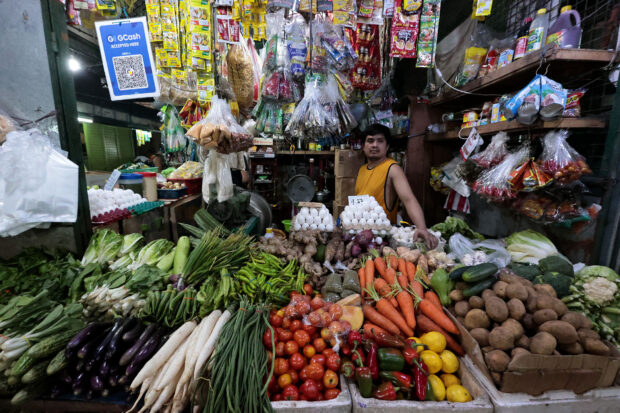
STILL WORRISOME | A market vendor watches over his goods as the government reported an unexpectedly good price inflation rate. (Photo by GRIG C. MONTEGRANDE / Philippine Daily Inquirer)
MANILA, Philippines — The fast rate of growth in the prices of goods and services commonly used by households remains a top government concern even as inflation eased much more than expected to 7.6 percent in March — its slowest pace in six months or since it reached 6.9 percent in September 2022. Last month, consumers paid P7.60 more for goods that cost P100 from a year ago.
The resulting number for March suggested that inflation had indeed peaked in January, when it hit 8.7 percent.
In a press briefing, National Statistician Dennis Mapa said the slower inflation in March was mainly due to slower price increases in three groups of commodities — food and nonalcoholic beverages; transportation; and housing, water, electricity, gas and other fuels.
Among the 13 groups of commodities being monitored to estimate inflation, two others showed slower price increases in March compared to the same month last year. These were health as well as information and communication.
On the other hand, five commodity groups showed continually higher inflation. These were alcoholic beverages and tobacco; clothing and footwear; recreation, sports, and culture; restaurants and accommodation services; and personal care and miscellaneous services.
Three groups of commodities registered the same rate of price increases as those recorded in February: furnishings; household equipment and routine household maintenance; and education services.
Main driver
Among food items alone, inflation slowed to 9.5 percent in March, compared to 11.1 percent in February, thanks to a slowdown in price hikes for vegetables, meat, and sugar. Mapa said the food basket alone contributed 3.3 percent or more than two-fifths to the 7.6 percent inflation in March.
“Onions accounted for 0.2 percentage points as did rice and also bread while sugar contributed 0.3 percentage points, fish 0.6 percentage points and meat 0.3 percentage points,” he added.“While food inflation is slowing down, these items account for relatively significant contributions to headline inflation,” the country’s chief statistician said.
From January to March, inflation averaged at 8.3 percent with the Bangko Sentral ng Pilipinas (BSP) noting that this was far above the government’s average inflation target range of 2 percent to 4 percent for the full year.
It said in a statement that the March inflation number was consistent with its assessment that the monthly average would remain high in the next several months but then gradually slide back down toward the target range for this year.
“Nevertheless, the risks to the inflation outlook continue to lean toward the upside,” the BSP said, meaning that actual readouts were more likely to be higher than lower compared to its forecast.